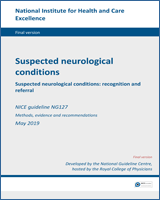| 5.2.1 Dizziness and vertigo in adults | Diagnostic and clinical prediction | In adults and young people who present with dizziness or vertigo, what is the accuracy of accompanying signs and symptoms to support non-specialists in identifying neurological conditions? | Main outcomes:
Sensitivity (%) and specificity (%) Area under the ROC curve (AUROC) – measure of predictive accuracy Positive/negative predictive value
Other outcomes:
Adjusted odds ratios for the presence of the following conditions:
central nervous system causes such as posterior circulation strokes and other (migraines, tumours) peripheral vestibular disorders, including posterior semi-circular canal dehiscence, BPPV, and labyrinthitis cardiovascular disorders (presyncope, postural hypotension) functional disorders vertebrobasilar insufficiency.
|
| 5.2.2 Dizziness and vertigo in adults | Diagnostic | In people with suspected (or under investigation for) new onset of vertigo or dizziness, is the HINTS (Head-Impulse—Nystagmus—Test-of-Skew) test effective in identifying whether there is a central nervous system cause, as indicated by the reference standard, MRI? | Main outcomes:
Sensitivity (%) and specificity (%) Area under the ROC curve (AUROC) – measure of predictive accuracy Positive/negative predictive value
|
| 5.3 Atraumatic facial pain in adults | Diagnostic and clinical prediction | In adults who present with atraumatic facial pain, what is the accuracy of accompanying signs and symptoms to support non-specialists in identifying suspected neurological conditions? | Main outcomes:
Sensitivity (%) and specificity (%) Area under the ROC curve (AUROC) – measure of predictive accuracy Positive/negative predictive value
Other outcomes:
Adjusted odds ratios for the presence of the following conditions:
|
| 5.8.2 Memory tests in adults | Diagnostic | In adults under 40 with suspected (or under investigation for) memory failure, what is the negative predictive value of neuropsychological assessments in ruling out organic memory failure? | Main outcomes:
Sensitivity (%) and specificity (%) Area under the ROC curve (AUROC) – measure of predictive accuracy Positive/negative predictive value
|
| 5.10 Sensory symptoms such as tingling or numbness | Diagnostic and clinical prediction | In people (adults, young people and children) who present with tingling or altered sensation in the body, what is the accuracy of accompanying signs and symptoms to support non-specialists in identifying suspected neurological conditions? | Main outcomes:
Sensitivity (%) and specificity (%) Area under the ROC curve (AUROC) – measure of predictive accuracy Positive/negative predictive value
Other outcomes:
Adjusted odds ratios for the presence of the following conditions:
compression neuropathy (for example, carpal tunnel syndrome and Meralgia parasthetica) demyelination drug toxicity – chemotherapy, alcohol, platinum-based drugs functional (hyperventilation) mononeuropathy multiplex peripheral neuropathy radiculopathy seizures small fibre neuropathy TIAs tethering of the spinal cord.
|
| 5.15 Tremor in adults | Diagnostic and clinical prediction | In adults and young people who present with tremor, what is the accuracy of accompanying signs and symptoms to support non-specialists in identifying neurological conditions? | Main outcomes:
Sensitivity (%) and specificity (%) Area under the ROC curve (AUROC) – measure of predictive accuracy Positive/negative predictive value
Other outcomes:
Adjusted odds ratios for the presence of the following conditions:
|
| 7.2 Blackouts and paroxysmal events in children | Diagnostic and clinical prediction | In children and babies who present with paroxysmal events, what is the accuracy of accompanying signs and symptoms to support non-specialists in identifying suspected neurological conditions? | Main outcomes:
Sensitivity (%) and specificity (%) Area under the ROC curve (AUROC) – measure of predictive accuracy Positive/negative predictive value
Other outcomes:
Adjusted odds ratios for the presence of the following conditions:
behavioural (that is, temper tantrums, breath-holding attacks and emotional disorders) cardiac disorders – long QT, left ventricular outflow obstruction epilepsy reflex anoxic seizures vasovagal syncope or postural hypotension.
|
| 7.5 Headaches in children | Diagnostic and clinical prediction | In children under 12 who present with headache, what is the accuracy of accompanying signs and symptoms to support non-specialists in identifying suspected neurological conditions? | Main outcomes:
Sensitivity (%) and specificity (%) Area under the ROC curve (AUROC) – measure of predictive accuracy Positive/negative predictive value
Other outcomes:
Adjusted odds ratios for the presence of the following conditions:
brain tumour chronic daily headaches hydrocephalus idiopathic intracranial hypertension intracranial infection migraine nocturnal hypoventilation raised intracranial pressure sinusitis venous sinus thrombosis.
|
| 7.6 Head shape or size abnormalities in children | Diagnostic and clinical prediction | In children and babies who present with abnormal head shape or size, what is the accuracy of accompanying signs and symptoms to support non-specialists in identifying neurological problems? | Main outcomes:
Sensitivity (%) and specificity (%) Area under the ROC curve (AUROC) – measure of predictive accuracy Positive/negative predictive value
Other outcomes:
Adjusted odds ratios for the presence of the following conditions:
|
| 7.9.2 Motor developmental delay in children | Diagnostic | In children and infants under 10 years of age who present with motor developmental delay, is a creatine kinase (CK) test accurate in identifying whether muscular dystrophy is present as compared to no test (and as indicated by the reference standard, diagnosis at follow-up)? | Main outcomes:
Sensitivity (%) and specificity (%) Area under the ROC curve (AUROC) – measure of predictive accuracy Positive/negative predictive value
|
